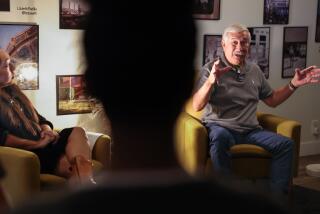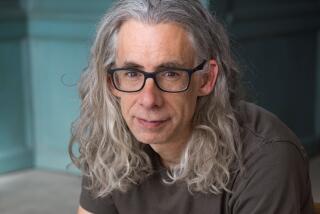Student Fiction Has the Ring of History
MADERA, Calif. â Students in junior high school teacher Bill Coateâs U.S. history classes in this San Joaquin Valley town not only learn history, they write biographical novels.
Their first two novels, âThe Minturn Chroniclesâ and âThe Saga of Caney Creek,â were printed locally, and novelist Irving Stone was so impressed by the young authors that he wrote forewords to the books.
The 83-year-old novelist visited Madera last year to share the experience of writing with the 12-year-olds who wrote âThe Minturn Chronicles.â During his visit he observed:
âChildren donât want to read or write because teachers donât excite them. It doesnât have to be that way. Thousands of teachers all over the country should follow Bill Coateâs example and get their students involved in reading and writing.â
Stone, who calls Coateâs method of teaching âThe Madera Movementâ is author of biographical novels that have sold more than 30 million copies, including âThe Agony and Ecstasy,â âLust for Lifeâ and his most recent, âDepths of Glory.â
Coate, 45, became a teacher when he was 30 after working in the grocery business 10 years. He was inspired to push his students into novel writing about five years ago when a friend spraying insecticide along a river bank on a Madera County farm happened upon three weed-choked 19th-Century granite tombstones.
âI wondered who these people were--a man, Jonas Minturn, 1819-1884; his wife, Abby West Minturn, 1820-1899, and their son, Rowland Minturn, 1845-1894. I decided I would make the Minturns the subject of a yearlong project in my sixth-grade history class,â Coate said.
He took his students to the graves, where they made rubbings from the headstones. The rubbings included the epitaph on Abby Minturnâs granite marker: âHer children shall arise and call her blessed.â
Coate and his 36 sixth graders made numerous trips to the Madera County courthouse searching census records, deeds, wills and various other legal documents containing information about the family. The students checked old newspapers and genealogical records. They uncovered 200 primary source documents with references to Jonas and Abby Minturn.
They found a descendant, Elizabeth Denning, 70, a great-granddaughter of the Minturns, living in Santa Cruz, and she invited the class to her home. There she showed the students furniture, china and other possessions of her great-grandparents.
She also provided them with a great deal of information about her ancestors.
Other background was developed by a junior high school class in Bristol, R. I., Jonas and Abby Minturnâs home before they moved to California in 1870. Coate made contact with a teacher at the Rhode Island school.
Then each of Coateâs 36 students assumed Abby Minturnâs identity and wrote a fictionalized chapter representing a year of her life, based on facts gathered during their research.
âWe marched through the 19th Century with Abby, grew up with her and lived with her until her death in 1899,â said Coate. âHaving Irving Stone write the foreword to our book and having him appear before our class was pure elixir.â
The class contracted with a Fresno printer to publish 500 copies of âThe Minturn Chronicles,â which sold for $10 each. Proceeds went to the establishment of an annual college history scholarship for a Madera High School student.
âThe Minturn Chroniclesâ was the class project for 1984-85. Then, Joan Perry of Madera County, a great-granddaughter of a Confederate soldier from Texas, heard about Coate and presented the teacher with 100 letters written by her ancestors, Sam Hardeman and his wife, Sally, during the Civil War.
That became the class project for 1985-86. Students in junior high classes in Madera taught by Coate and by Arthur Davis, and seventh graders in Bay City, Tex., used the letters and supporting historical evidence to write âThe Saga of Caney Creek.â
Students at Bay City, near Caney Creek where the Hardemans owned a plantation, collected information from the archives of Matagorda County. âThe Saga of Caney Creekâ became a major sesquicentennial celebration for the Texas county.
A Texas barbecue held near the graves of Sam and Sally Hardeman attracted their descendants from several states, many of whom had never heard of each other. Students from Madera and Bay City read passages from their book, which sells for $19.95 a copy. Three hundred copies were printed.
It was at the barbecue that Coate was approached by Texas cattleman David E. Stewart, 50, who presented the teacher with two unpublished diaries written by William P. Huff, his great-great-grandfather, that have become the basis of the California teacherâs history project for school year 1986-87. âI almost had cardiac arrest when Stewart gave me the diaries,â Coate said.
Huff was a paleontologist whose collections of mastodon bones are housed in the British Museum and Harvard University. The scientist led a party of 22 gold seekers on an overland journey in wagon trains from Texas to California in 1849.
The journals describe daily events of the trip in great detail. Huffâs group teamed up with another party headed for California gold camps, led by the first provisional governor of Texas, Henry Smith.
âOver and Overâ
Every morning for an hour at Brenda Junior High, Coate and his 39 eighth graders read from Huffâs 137-year-old diary. Each day they review the events of the journey.
âWe go over and over the material. I ask students questions about what has transpired. In coming months the class will be writing its biographical novel in Huffâs style,â explained Coate.
The journals were not finished. They end at Yuma at the Colorado River, the gateway to California. Coateâs class has found the names of every member of Huffâs party on the Mariposa County census for 1850. They know Huff died in 1886. They have found references to him and his party in other gold rush diaries.
They are searching for additional clues about Huff at the Huntington Library in San Marino, at the Bancroft Library in Berkeley and in local archives in Mariposa County.
Junior high school students in Van Vleck, Austin and El Paso, Tex., and in Tucson are also involved in this yearâs project. Students from the three states will write this third biographical novel together.
Follow the Journey
âThe project will culminate next June,â Coate said. âStudents in Van Vleck, where the journey started, will come to Madera and present a play about the overland expedition.
âThey and their parents will follow the same route covered by Huff and pick up parents and students from the other schools involved in the project as they move westward. Here in Madera, the students from the three states will read portions of their contributions for the book. A half dozen historians will conduct a symposium.â
Coate said the program will conclude with a two-day, 40-mile wagon train trip from Madera to Mariposa and the gold country where Huff and his party worked their diggings.
More to Read
Sign up for our Book Club newsletter
Get the latest news, events and more from the Los Angeles Times Book Club, and help us get L.A. reading and talking.
You may occasionally receive promotional content from the Los Angeles Times.







